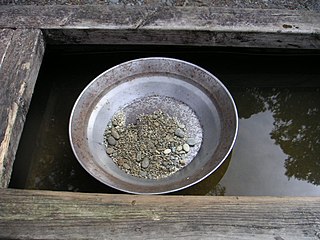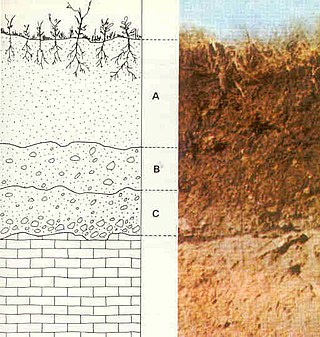
Ore is natural rock or sediment that contains one or more valuable minerals concentrated above background levels, typically containing metals, that can be mined, treated and sold at a profit. The grade of ore refers to the concentration of the desired material it contains. The value of the metals or minerals a rock contains must be weighed against the cost of extraction to determine whether it is of sufficiently high grade to be worth mining and is therefore considered an ore. A complex ore is one containing more than one valuable mineral.

Kimberlite, an igneous rock and a rare variant of peridotite, is most commonly known to be the main host matrix for diamonds. It is named after the town of Kimberley in South Africa, where the discovery of an 83.5-carat diamond called the Star of South Africa in 1869 spawned a diamond rush and led to the excavation of the open-pit mine called the Big Hole. Previously, the term kimberlite has been applied to olivine lamproites as Kimberlite II, however this has been in error.

Malachite is a copper carbonate hydroxide mineral, with the formula Cu2CO3(OH)2. This opaque, green-banded mineral crystallizes in the monoclinic crystal system, and most often forms botryoidal, fibrous, or stalagmitic masses, in fractures and deep, underground spaces, where the water table and hydrothermal fluids provide the means for chemical precipitation. Individual crystals are rare, but occur as slender to acicular prisms. Pseudomorphs after more tabular or blocky azurite crystals also occur.

Mining in the engineering discipline is the extraction of minerals from the ground. Mining engineering is associated with many other disciplines, such as mineral processing, exploration, excavation, geology, metallurgy, geotechnical engineering and surveying. A mining engineer may manage any phase of mining operations, from exploration and discovery of the mineral resources, through feasibility study, mine design, development of plans, production and operations to mine closure.

Prospecting is the first stage of the geological analysis of a territory. It is the search for minerals, fossils, precious metals, or mineral specimens. It is also known as fossicking.

Gold prospecting is the act of searching for new gold deposits. Methods used vary with the type of deposit sought and the resources of the prospector. Although traditionally a commercial activity, in some developed countries placer gold prospecting has also become a popular outdoor recreation. Gold prospecting has been popular since antiquity. From the earliest textual and archaeological references, gold prospecting was a common thread for gaining wealth.
Exploration geophysics is an applied branch of geophysics and economic geology, which uses physical methods at the surface of the Earth, such as seismic, gravitational, magnetic, electrical and electromagnetic, to measure the physical properties of the subsurface, along with the anomalies in those properties. It is most often used to detect or infer the presence and position of economically useful geological deposits, such as ore minerals; fossil fuels and other hydrocarbons; geothermal reservoirs; and groundwater reservoirs. It can also be used to detect the presence of unexploded ordnance.
Botanical prospecting for uranium is a method of finding uranium deposits either by observation of plant life growing on the surface, or by geochemical analysis of plant material in a process known as Geobotanical prospecting.
Andrew A. Snelling is a young-Earth creationist geologist who works for Answers in Genesis.
Iron oxide copper gold ore deposits (IOCG) are important and highly valuable concentrations of copper, gold and uranium ores hosted within iron oxide dominant gangue assemblages which share a common genetic origin.

Saprolite is a chemically weathered rock. Saprolites form in the lower zones of soil profiles and represent deep weathering of the bedrock surface. In most outcrops, its color comes from ferric compounds. Deeply weathered profiles are widespread on the continental landmasses between latitudes 35°N and 35°S.

A nickel mine is a mine that produces nickel. Some mines produce nickel primarily, while some mines produce nickel as a side-product of some other metal that has a higher concentration in the ore.
Brine mining is the extraction of useful materials which are naturally dissolved in brine. The brine may be seawater, other surface water, groundwater, or hyper-saline solutions from several industries. It differs from solution mining or in-situ leaching in that those methods inject water or chemicals to dissolve materials which are in a solid state; in brine mining, the materials are already dissolved.
Choquelimpie is a 5,327 metres (17,477 ft) high volcano in Chile. It is constructed from several separate layers of andesite and dacite on top of Tertiary and Precambrian layers. The volcano was active over six million years ago, with the neighbouring volcano Ajoya active over seven million years ago. Since then, erosion and glacial activity have dramatically reduced the height of the volcano and excavated a central depression.

A primary mineral is any mineral formed during the original crystallization of the host igneous primary rock and includes the essential mineral(s) used to classify the rock along with any accessory minerals. In ore deposit geology, hypogene processes occur deep below the Earth's surface, and tend to form deposits of primary minerals, as opposed to supergene processes that occur at or near the surface, and tend to form secondary minerals.
Helen Leighton Cannon was an American geologist specifying in geobotany and studying the effects of geological chemicals on the environment. She was a woman in science making large contributions to geology and advancements for women in science. She had a long lasting career at the United States Geological Survey in Washington, D.C., and Denver, Colorado, soon becoming well known for her research and important discoveries. Cannon, along with two colleagues at USGS, set up and participated in the first organized unit studying chemicals in the real environment. The team concluded that by analyzing plants in a given area they could determine what metals were present in the soil and earth in that same area. In 1952, Cannon published a paper based on the findings and this paved the way for more research in geology and plants, geobotany. This research developed further into an important association with health issues, including cancer, as well as aided the United States to find uranium deposits during the Cold War. As an author, she has been largely collected by libraries.
Quesnellia, or the Quesnel terrane, is a terrane in British Columbia, Canada; constituent of the Canadian Cordillera. It formed volcanic arc during the Mesozoic era, in the Triassic and Jurassic periods.
Michel Jébrak is a Franco-Canadian geologist, academic and a researcher. He is an emeritus professor at University of Quebec’s Department of Earth and Atmospheric Sciences. He is a former Vice-Rector for Research and Creation at UQAM and holder of the UQAT-UQAM Mining Entrepreneurship Chair.
Rachel Haymon is a marine geologist known for her work linking geological and biological processes occurring at deep-sea hydrothermal vents. In 2005 she was elected a fellow of the Geological Society of America.

Heterogenite is a natural tri-valent cobalt oxyhydroxide mineral. It is the most abundant oxidised cobalt mineral in the Katanga Copperbelt, a region in the Democratic Republic of the Congo. About 70% of known heterogenite is located in the DRC.

















